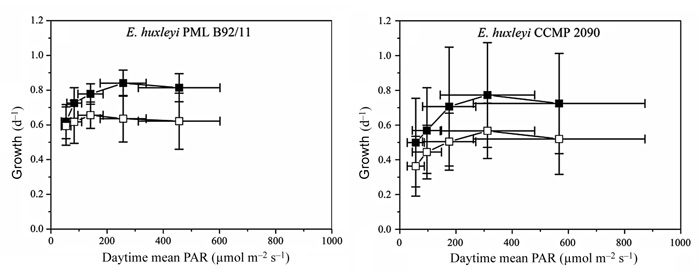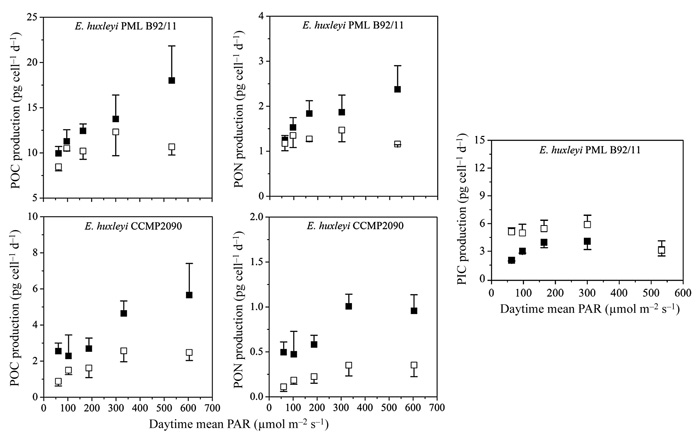| Follow @co2science |
Paper Reviewed
Jin, P., Ding, J., Xing, T., Riebesell, U. and Gao, K. 2017. High levels of solar radiation offset impacts of ocean acidification on calcifying and non-calcifying strains of Emiliania huxleyi. Marine Ecology Progress Series 568: 47-583.
Coccolithophores play an important role in the ocean carbon cycle. As a key group of marine primary producers, they sequester large amounts of carbon into the oceans via photosynthesis and calcification. However, concerns have been expressed that in the future these phytoplankton may respond negatively to the combined effects of ocean acidification (OA) and exposure to higher levels of solar radiation, the latter of which phenomena is hypothesized to occur in response to global warming that will intensify ocean stratification and shoaling of the upper mixed layer. Although much research has been conducted on the singular effects of OA and solar radiation on coccolithophores, to date very little is known about the possible interaction of these two phenomena.
Hoping to remedy this lack of knowledge, Jin et al. (2017) set out to investigate the "interactive effects of OA and increasing solar radiation on the physiology of a calcifying strain (PML B92/11) and a non-calcifying strain (CCMP 2090) of the coccolithophore Emiliania huxleyi." Their experiment was conducted over a period of 7 and 18 days for the calcifying and non-calcifying strains, respectively, in monospecific cultures that were grown semi-continuously outdoors under ambient (395 µatm) or elevated (1000 µatm) pCO2 levels and different levels of incident solar radiation.
In describing their findings, Jin et al. report they found that elevated pCO2 alone "enhanced the growth of both strains [of coccolithophores]," stimulating growth by 15-24 percent in the calcifying strain and by 22 to 28 percent in the non-calcifying strain. (Figure 1). In combination, elevated pCO2 and increased solar radiation density "acted synergistically to enhance growth in the calcifying but not in the non-calcifying strain." Additionally, the authors report that elevated pCO2 "enhanced the particulate organic carbon (POC) and nitrogen (PON) productions in both strains," which effect was more pronounced at higher levels of solar radiation (see Figure 2). Lastly, in the calcifying strain, they also found that high pCO2 decreased calcification at low solar radiation levels (see Figure 2 also); but they say "it did not cause a significant effect at high levels of solar radiation," which observation "imply[s] that a sufficient supply of light energy can offset the impact of OA on the calcifying strain."
In light of all of their findings listed above, Jin et al. conclude that "since both pCO2 (IPCC, 2013) and integrated light density in the upper mixed layer (Sarmiento et al., 2004) are projected to continue to rise in the future ocean, our findings imply that POC production of coccolithophores (both calcifying and non-calcifying) will increase." And that is great news for this key microscopic phytoplankton species.

Figure 1. Growth rates of Emiliania huxleyi grown under ambient (395 ?atm) and elevated (1000 µatm) CO2 conditions: (Left panel) calcifying strain PML B92/11 under 6.5, 10, 17, 31, 55% levels of incident solar radiation; (Right panel) non-calcifying strain CCMP 2090 under 10, 17, 31, 55 and 100% levels of incident solar radiation. Values are mean ± SD for replicate cultures (n = 3) in outdoor experimental phases (7 d for strain PML B92/11 and 18 d for strain CCMP 2090). Source: Jin et al. (2017).

Figure 2. Particulate organic carbon (POC, Left Panel) and nitrogen (PON, Middle Panel) production rates and particulate inorganic carbon (PIC, Right Panel) production rates of Emiliania huxleyi grown under ambient (open squares) and increased (filled squares) CO2 conditions and different solar radiation levels. Values are mean and SD (n = 3). Source: Jin et al. (2017).
References
IPCC (Intergovernmental Panel on Climate Change). 2013. Summary for Policymakers. In: Stocker, T.F., Qin, D., Plattner, G.K., Tignor, M. and others (eds) Climate change 2013: the physical science basis. Contribution of Working Group I to the Fifth Assessment Report of the Intergovernmental Panel on Climate Change. Cambridge University Press, Cambridge, p 3-33.
Sarmiento J., Slater, R., Barber, R., Bopp, L. and others. 2004. Response of ocean ecosystems to climate warming. Global Biogeochemical Cycles 18: GB3003.
Posted 19 October 2017



